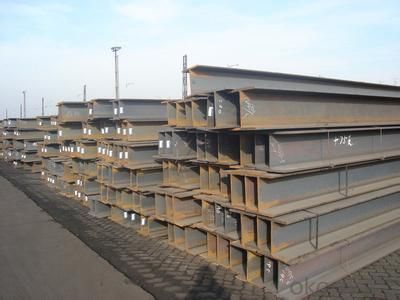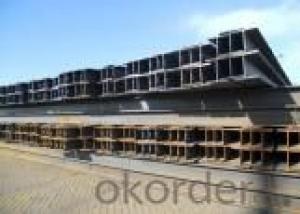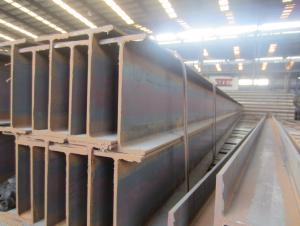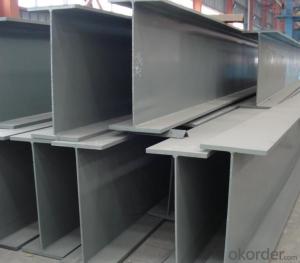H Beam Jis Standard With High Quality
- Loading Port:
- China Main Port
- Payment Terms:
- TT or LC
- Min Order Qty:
- -
- Supply Capability:
- -
OKorder Service Pledge
OKorder Financial Service
You Might Also Like
OKorder is offering H beam JIS Standard with high quality at great prices with worldwide shipping. Our supplier is a world-class manufacturer of steel, with our products utilized the world over. OKorder annually supplies products to European, North American and Asian markets. We provide quotations within 24 hours of receiving an inquiry and guarantee competitive prices.
Product Applications:
H beam JIS Standard with high quality are ideal for structural applications and are widely used in the construction of buildings and bridges, and the manufacturing, petrochemical, and transportation industries.
Product Advantages:
OKorder's H beam JIS Standard with high quality are durable, strong, and resist corrosion.
Main Product Features:
· Premium quality
· Prompt delivery & seaworthy packing (30 days after receiving deposit)
· Corrosion resistance
· Can be recycled and reused
· Mill test certification
· Professional Service
· Competitive pricing
Product Specifications:
1. Standard: JIS 3192
2. Grade: SS400 or Equivalent
3. Length: 10m, 12m as following table
4. Invoicing on theoretical weight or actual weight as customer request
5.Payment: TT or L/C
Size and Mass of H beam:
Size (mm) | Mass (Kg/m) | Size (mm) | Mass (Kg) |
100*100*6.0 | 16.9 | 148*100*6.0 | 20.7 |
125*125*6.5 | 23.6 | 150*150*7.0 | 31.1 |
150*75*5.0 | 14.0 |
1. Packing: it is nude packed in bundles by steel wire rod
2. Bundle weight: not more than 3.5MT for bulk vessel; less than 3 MT for container load
3. Marks:
Color marking: There will be color marking on both end of the bundle for the cargo delivered by bulk vessel. That makes it easily to distinguish at the destination port.
Tag mark: there will be tag mark tied up on the bundles. The information usually including supplier logo and name, product name, made in China, shipping marks and other information request by the customer.
If loading by container the marking is not needed, but we will prepare it as customer request.
FAQ:
Q1: Why buy Materials & Equipment from OKorder.com?
A1: All products offered byOKorder.com are carefully selected from China's most reliable manufacturing enterprises. Through its ISO certifications, OKorder.com adheres to the highest standards and a commitment to supply chain safety and customer satisfaction.
Q2: Can fit in the containers of 20fts the steel beams of 6M?
A2: No proble, we can put them into the containers in the form sideling.
Q3: The products are invoicing on theoritical weight or on actual weight?
A3: We can do it in both manners, according to the customers' request.
Images:


- Q:Can steel H-beams be used in telecommunications towers?
- Telecommunications towers can indeed utilize steel H-beams. The reason behind this preference lies in the strength and durability that steel H-beams bring to construction projects. These beams offer exceptional structural support, enabling them to endure heavy loads and withstand harsh weather conditions. Consequently, they prove to be an ideal fit for telecommunications towers, which necessitate a sturdy and stable framework to uphold antennas and other essential equipment. As a result of their requisite strength and stability, steel H-beams have become a favored option when constructing telecommunications towers.
- Q:Can steel H-beams be used in utility infrastructure projects?
- Yes, steel H-beams can be used in utility infrastructure projects. Steel H-beams are commonly used in construction due to their strength and durability. They are particularly suitable for utility infrastructure projects because they can bear heavy loads and provide structural support. H-beams are often used in the construction of bridges, buildings, and other large structures, making them an ideal choice for utility infrastructure projects such as power plants, water treatment plants, and transmission towers. Additionally, steel H-beams are resistant to harsh weather conditions and can withstand natural disasters like earthquakes and hurricanes, making them a reliable choice for long-term utility infrastructure projects.
- Q:What are the considerations when designing for natural disaster planning in Steel H-Beams?
- When designing for natural disaster planning in Steel H-Beams, there are several important considerations that need to be taken into account. 1. Load-bearing capacity: The first and foremost consideration is ensuring that the H-Beams have sufficient load-bearing capacity to withstand the forces exerted during a natural disaster. This involves calculating the maximum expected loads and stresses that the beams may experience, and designing them to safely handle these forces. 2. Material selection: The choice of materials for the H-Beams is crucial in natural disaster planning. Steel is often the preferred material due to its high strength and durability. The steel used should possess appropriate mechanical properties, such as high tensile strength and ductility, to withstand the dynamic forces associated with natural disasters. 3. Design codes and standards: Compliance with relevant design codes and standards is essential to ensure the structural integrity of the H-Beams. These codes provide guidelines on factors such as minimum safety factors, design loads, and construction practices specific to natural disaster-prone areas. 4. Structural redundancy: Incorporating redundancy into the design is important to enhance the resilience of the structure. This can be achieved by providing additional beams or bracing elements to distribute the loads more evenly and prevent the collapse of the entire structure in case of localized failures. 5. Seismic considerations: If the natural disaster being planned for is an earthquake, additional seismic considerations need to be taken into account. This includes designing the H-Beams to withstand the ground motion induced by earthquakes and incorporating seismic isolation or energy dissipation devices to reduce the impact of seismic forces on the structure. 6. Connection details: The connection details between the H-Beams and other structural elements are critical for overall structural stability. These connections should be designed to resist the anticipated forces and moments, and should be capable of maintaining their integrity during a natural disaster. 7. Construction and maintenance: Lastly, considerations for ease of construction and maintenance should be incorporated into the design. This includes ensuring that the H-Beams can be installed and maintained easily, as well as providing provisions for regular inspections and repairs to maintain their structural integrity over time. By carefully considering these factors, designers can create H-Beam structures that are resilient and capable of withstanding the forces imposed by natural disasters, thereby ensuring the safety of the occupants and minimizing damage to the overall infrastructure.
- Q:What are the considerations when designing for thermal bridging in Steel H-Beams?
- When designing for thermal bridging in Steel H-Beams, there are several important considerations to keep in mind. Firstly, it is crucial to consider the thermal conductivity of the steel material itself, as it can significantly impact heat transfer through the beams. Secondly, the design should account for the potential for thermal bridging at connections or joints, where heat can easily transfer between the beams and the surrounding components. Insulation materials or thermal breaks can be implemented at these points to minimize heat loss. Additionally, the overall design should aim to minimize the surface area of the beams that is exposed to the exterior environment, as this can reduce the potential for heat transfer. Proper insulation and thermal analysis should be performed to ensure that the H-Beams meet the required thermal performance standards and minimize energy loss.
- Q:Are steel H-beams resistant to earthquakes?
- Yes, steel H-beams are highly resistant to earthquakes. Their structural design and material properties make them capable of withstanding seismic forces and vibrations, ensuring the safety and stability of buildings and structures in earthquake-prone areas.
- Q:How do steel H-beams perform in areas with high rainfall or moisture?
- Steel H-beams perform well in areas with high rainfall or moisture as steel is relatively resistant to corrosion. However, to ensure long-term durability, it is important to apply appropriate protective coatings to prevent rusting and maintain structural integrity. Regular maintenance and inspections are also recommended to identify any potential issues and address them promptly.
- Q:Can steel H-beams be recycled?
- Yes, steel H-beams can be recycled. Steel is one of the most recycled materials in the world, and H-beams made of steel are no exception. Recycling steel H-beams not only helps reduce the environmental impact of mining and manufacturing new steel, but also conserves energy and resources. The recycling process typically involves collecting the H-beams, sorting them according to their steel grade, and then melting them down in a furnace. The molten steel is then used to create new steel products, including H-beams or other structural components. By recycling steel H-beams, we can contribute to a more sustainable and circular economy.
- Q:How are steel H-beams transported and stored?
- Steel H-beams, which are widely used in the construction industry for their strength and durability, are transported and stored in a specific manner to ensure their safety and ease of handling. During transportation, steel H-beams are typically loaded onto flatbed trucks or trailers. They are secured using chains or straps to prevent movement or shifting during transit. It is important to distribute the weight evenly and ensure that the beams are properly balanced on the truck to prevent any accidents or damage to the beams. When it comes to storage, steel H-beams are usually stored horizontally in designated areas, such as warehouses or construction sites. They are often stacked on steel racks or placed on the ground, ensuring that they are not in contact with the ground to avoid any corrosion. To protect the H-beams from environmental factors like rain, snow, or excessive sunlight, they are often covered with a tarp or stored indoors. This helps prevent rust and deterioration that can affect the integrity of the beams. Additionally, careful consideration is given to the storage layout to ensure accessibility and ease of retrieval. H-beams are typically organized based on their size and weight, with proper labeling or identification to facilitate easy identification and retrieval when needed. Proper handling and storage of steel H-beams are crucial to maintain their structural integrity and prevent any damage that may affect their performance in construction projects. Following these guidelines ensures that the beams are transported and stored safely, allowing for efficient construction processes and long-lasting structures.
- Q:Can steel H-beams be used for data centers?
- Indeed, data centers can utilize steel H-beams. These beams are frequently employed in construction endeavors as they possess impressive strength, endurance, and load-bearing capacities. In order to sustain the weight of equipment and infrastructure, data centers necessitate robust and steadfast structures, making steel H-beams an ideal choice. Moreover, H-beams can be effortlessly assembled and tailored to fit the precise layout and needs of a data center. By employing steel H-beams, data centers guarantee the stability and structural soundness vital for supporting the crucial operations and equipment housed within these establishments.
- Q:Calculation method of H steel area
- H section steel is a kind of economical section high efficiency profile with more optimized sectional area distribution and stronger weight ratio. It is named after the English letter "H". Because all the sections of H steel are arranged at right angles, H steel has been widely used in all directions for its advantages of high bending resistance, simple construction, cost saving and light weight.
1. Manufacturer Overview |
|
|---|---|
| Location | |
| Year Established | |
| Annual Output Value | |
| Main Markets | |
| Company Certifications | |
2. Manufacturer Certificates |
|
|---|---|
| a) Certification Name | |
| Range | |
| Reference | |
| Validity Period | |
3. Manufacturer Capability |
|
|---|---|
| a)Trade Capacity | |
| Nearest Port | |
| Export Percentage | |
| No.of Employees in Trade Department | |
| Language Spoken: | |
| b)Factory Information | |
| Factory Size: | |
| No. of Production Lines | |
| Contract Manufacturing | |
| Product Price Range | |
Send your message to us
H Beam Jis Standard With High Quality
- Loading Port:
- China Main Port
- Payment Terms:
- TT or LC
- Min Order Qty:
- -
- Supply Capability:
- -
OKorder Service Pledge
OKorder Financial Service
Similar products
New products
Hot products
Related keywords




























